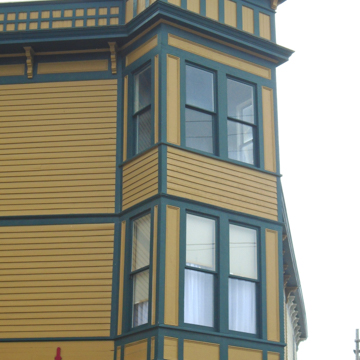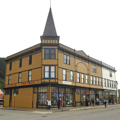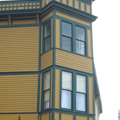The false front of this three-story building, the largest in Skagway, hides plain buildings and a fascinating history. In 1908, amid a movement to consolidate commercial buildings onto Broadway, Chris Shea and Fred Patten bought some barracks left by the U.S. Army in 1904, when it had transferred its troops to Haines. A two-and-a-half-story, 25-foot-by-100-foot barrack, which had been built in 1904 on Sixth near Broadway, was cut in half and moved to this corner site; the two halves were positioned with their gable ends facing Broadway, creating two separate buildings. Another barrack, with dimensions of 25 feet by 50 feet when it was built in 1900 and later increased 15 feet in length, was moved next to them. A false front was constructed over the first two buildings as part of its conversion to The Trail, a tourist resort and saloon. The first floor was devoted to a series of storefronts, while the upper stories were
The third building, the 65-foot-long barrack, was leased to John J. Kennedy and Henry J. Lynch, who established a haberdashery. Removing the front of the building and constructing a 9-foot-wide connector to The Trail, Lynch and Kennedy built a false front to match the one next door. (The paired windows in the third floor are centered in the gable of the old barrack; those windows are off-center in the finished building because of the connector.) The first-floor sales room was the largest in Skagway, at 34 feet by 50 feet.
Neither business met with great success. The Trail venture went bankrupt in 1909. Soon after, Kennedy sold out to Lynch, who continued the clothing store until his death in 1915. The exotic building illustrates the vagaries of commercial enterprise, the mobility of Skagway buildings, and the nature of false fronts: a peek at the rear of this ensemble shows three, distinct, barracklike buildings.




